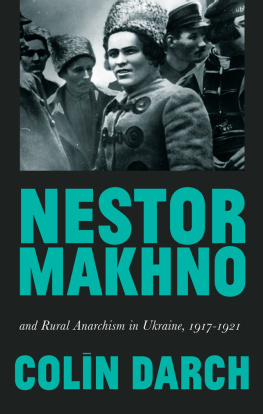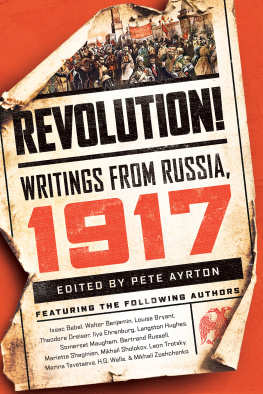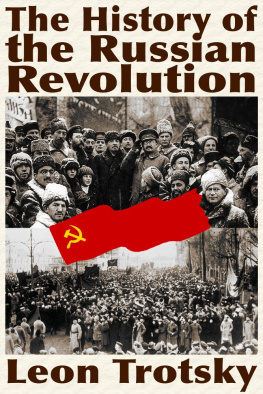

The transition from a world war to a civil war required a delicate sense of balance for most participants. Not every officer supported the anti-Bolsheviks, nor did every ordinary serviceman support the revolutionaries.

First published in Great Britain in 2012 by
PEN & SWORD MILITARY
an imprint of
Pen & Sword Books Ltd,
47 Church Street,
Barnsley,
South Yorkshire.
S70 2AS
Copyright Nik Cornish, 2012
ISBN 978 1 84884 375 2
eISBN 978 1 78303 876 3
The right of Nik Cornish to be identified as Author of this work has been asserted by him in accordance with the Copyright, Designs and Patents Act 1988.
A CIP record for this book is available from the British Library.
All rights reserved. No part of this book may be reproduced or transmitted in any form or by any means, electronic or mechanical including photocopying, recording or by any information storage and retrieval system, without permission from the Publisher in writing.
Typeset by Chic Media Limited.
Printed and bound by CPI Group (UK) Ltd, Croydon, CR0 4YY.
Pen & Sword Books Ltd incorporates the Imprints of
Pen & Sword Aviation, Pen & Sword Family History, Pen & Sword
Maritime, Pen & Sword Military, Pen & Sword Discovery, Wharncliffe Local
History, Wharncliffe True Crime, Wharncliffe Transport, Pen & Sword
Select, Pen & Sword Military Classics, Leo Cooper,
The Praetorian Press, Remember When, Seaforth Publishing and
Frontline Publishing.
For a complete list of Pen & Sword titles please contact
Pen & Sword Books Limited
47 Church Street, Barnsley, South Yorkshire, S70 2AS, England
E-mail: enquiries@pen-and-sword.co.uk
Website: www.pen-and-sword.co.uk
Contents
Acknowledgements and Photographic sources
As ever my thanks are extended to Dmitri Belanovsky who had family on both sides of the political divide and never hesitates to provide lucid commentary on the text and captions. Further thanks are due to Norbert Hofer, Andrei Simonov and Stephen Perry.
This book is dedicated to Dorothy (my mum), Angie (partner and RCW widow) and Alex, Charlotte and James daddys little soldiers! And to a veteran, the late Nicholas Volkov-Mouromtsov (United Cuirassier Regiment, Volunteer Army), who encouraged my interest in this period and August G. Blume, a deeply missed friend and inspiration of many years.
Images are taken from the following sources:
From the Fonds of the RGAKFD in Krasnogorsk: pp. 13 (top), 13 (bottom), 27, 31 (top), 38 (top), 40 (top), 42 (bottom), 45 (top), 54 (bottom), 56 (top), 58 (top), 58 (bottom), 59 (top), 78 (bottom), 80, 81 (bottom), 83 (top left), 83 (bottom), 95 (top), 97 (bottom), 98 (bottom), 99 (top), 99 (bottom), 100 (bottom), 102 (bottom), 107, 108 (top), 108 (bottom), 109 (top), 109 (bottom), 110 (top), 111 (bottom), 112 (top), 113 (bottom), 114 (top), 116 (top), 116 (bottom), 121 (top), 122, 123 (top), 124 (top), 125 (top), 126 (top), 127 (bottom), 129 (top), 129 (bottom), 130 (bottom), 137 (bottom), 138 (bottom), 139 (top), 139 (bottom), 140 (bottom), 143 (top).
Courtesy of the Central Museum of the Armed Forces Moscow: pp. 14 (top), 15, 21, 22, 23 (top), 23 (bottom), 24, 25, 26 (bottom), 29 (bottom), 30 (top left), 30 (top right), 30 (bottom), 31 (bottom), 32 (bottom), 38 (bottom), 39 (top right), 40 (bottom), 44 (top), 46 (top), 46 (bottom), 56 (bottom), 57 (top), 57 (bottom), 59 (bottom), 73 (top), 79, 81 (top), 85 (top), 86 (top), 87 (bottom), 98 (top), 100 (top), 110 (bottom), 111 (top), 112 (bottom), 113 (top), 115 (top), 115 (bottom), 124 (bottom), 125 (bottom), 127 (top), 128 (top), 128 (bottom), 130 (top), 137 (top), 141 (top), 141 (bottom), 142 (top), 143, 144 (bottom).
From the Andrei Simonov Collection: pp. 32 (top), 50, 52 (bottom), 53 (top left), 53 (bottom), 54 (top), 55 (top), 55 (bottom), 64, 65, 74, 96 (bottom).
Nik Cornish at Stavka: pp. 14 (bottom), 16, 26 (top), 27 (top), 27 (bottom), 29 (top), 37, 39 (top left), 39 (bottom), 41 (top), 41 (bottom), 42 (top), 43 (top), 43 (bottom), 44 (bottom), 45 (bottom), 51, 52 (top), 53 (top right), 60, 66 (top), 66 (bottom), 67, 68 (top), 68 (bottom), 69 (top), 69 (bottom), 70 (top), 70 (bottom), 71, 72 (top), 72 (bottom), 73 (bottom), 78 (top), 82 (top), 82 (bottom), 83 (top right), 84 (top), 84 (bottom), 85 (bottom), 86 (bottom), 87 (top), 88, 92, 93, 94 (top), 94 (bottom), 95 (bottom), 96 (top), 97 (top), 101 (top), 101 (bottom), 102 (top), 114 (bottom left), 114 (bottom right), 120, 121 (bottom), 123 (bottom), 126 (bottom), 136 (top), 136 (bottom), 138 (top), 140 (top), 142 (bottom), 144 (top).
Preface
T he purpose of this book is to give the general reader of history, military or otherwise, a heavily illustrated overview of the events, personalities and places that came together to compose the Russian revolutions and subsequent civil war during the period 19171921. As my starting point I have taken the abdication of Nicholas II Romanov and ended with the Kronstadt Uprising in 1921. I have no particular political axe to grind in this matter having spoken to and discussed the matter with veterans that had both anti- and pro-communist sympathies, all of whom expressed the common goal of having the improvement of russia as their guiding principle. Sadly, all are now deceased but I hope, from the notes I took during our conversations, to help others make some sense of the brutal, fratricidal lunacy that engulfed one-sixth of the worlds land mass and involved over 150 million people.
I apologize in advance for what some may perceive as an over-simplistic approach to the tangled politics of this period but exonerate myself by the need to condense billions of words into less than 25,000.
The images are mainly drawn from Russian archives, particularly that of the Central Museum of the Armed Forces, Moscow to which I owe a great debt of gratitude for many years of support, help and understanding.
In a break with tradition I have used the western dating system throughout so that readers can parallel events elsewhere in the world without the tedium of adding 13 to Russian dates until February 1918.
Introduction
T he First World War was the catalyst for a wide variety of political and sociological changes across the face of the globe; of these one of the most important for the history of the twentieth century and beyond were the Russian revolutions of 1917. The roots of these events lay in the decade before 1914 so an understanding of this period of Russian history is essential, as is the fact that the Russian empire was exactly that a land-based empire made up of diverse races, religious persuasions, languages, cultures and aspirations held in place by the increasingly moribund power of one family, the house of Romanov.
Until 1905 the Tsar of Russia held almost absolute power over the 150 million people of his domains. This system of government worked well enough until two factors came into play. The first of these was military defeat that undermined faith in the Tsars judgement and infallibility. The second was the perception of his personal weakness of character exemplified by indecisiveness. Both strands came together during and immediately following the defeat of Russia by Japan in 1905. The failure of Russias armed forces coincided with civil unrest which, at first confined to the major cities, rapidly spread across the empire and led to a spate of peasant uprisings. The Tsar, under pressure from his advisors, granted a constitution based on a relatively liberal franchise. However, as the disturbances died down the Tsar regained confidence in his former autocratic powers, and consequently he modified the franchise and curbed the powers of the Duma, the newly created parliament. As a result, the political condition of Russia was unsteady until economic and industrial expansion, combined with land reform, reduced overt discontent with the regime.
Next page















